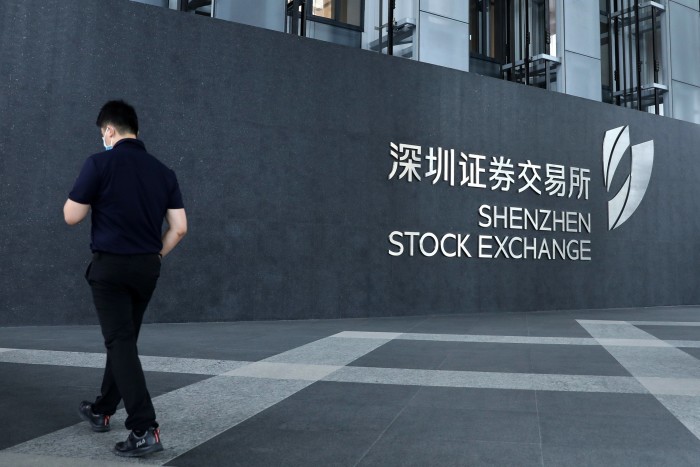Investors weigh up best ETFs to profit from China’s reopening

Simply sign up to the Exchange traded funds myFT Digest -- delivered directly to your inbox.
Latest news on ETFs
Visit our ETF Hub to find out more and to explore our in-depth data and comparison tools
When Chinese tech giant Alibaba announced it was splitting into six companies, trading of the KraneShares CSI China Internet ETF shot through the roof. More than $1bn-worth of stakes in the fund changed hands on hopes that Alibaba’s move signalled a longer-term easing of Beijing’s regulatory crackdown on the sector.
But the fund itself only saw inflows of about $25mn that day, reflecting a broader issue for China-focused ETFs this year: even as most investors agree that China’s economic recovery still has some steam left, many are hesitant to take the plunge.
“Sometimes, the activity on China ETFs doesn’t translate into a longer-term investment thesis,” explains Jason Lui, head of East Asia strategy at BNP Paribas.
Much like the broader market for Chinese equities, China ETFs experienced massive inflows at the start of the year, only for these to level off after a few ropey readings from economic indicators as well as geopolitical tensions between the US and China. It was enough to revive lingering questions from last year over whether China is investible.
Now, though, thanks to a recent string of strong readings on Chinese consumer confidence and broader economic activity, a consensus is growing among economists that the country’s recovery from its disruptive Zero-Covid policy is still on track.

Even so, any investor seeking exposure to China’s reopening economy through ETFs will still have to determine how best to do this. Strategists and analysts remain divided over which options to favour.
Lui says thematic and sector-specific funds in Hong Kong — including those focused on mid-cap stocks and technology stocks listed in mainland China — could benefit from policy support.
“That would be consistent with the macro view that China wants to stimulate growth, but they’ll do so in a more measured way,” he says. “It will be more individual stock or sector-specific, which should support a more thematic or targeted exposure.”
But Hong Kong is not the only option: investors also have to consider funds listed in the US, Europe and mainland China.
Jackie Choy, Hong Kong-based director of passive investment ratings at Morningstar, notes that ETF options in the US and Europe remained limited but that the number of fund options closer to home had risen in recent years.
“There are, in theory, a lot more China ETFs available to investors through Hong Kong, especially if we include the ETF Connect,” he says — referring to the facility, launched last year, for traders to use the city’s Stock Connect market link-up with exchanges in Shanghai and Shenzhen to invest directly in mainland-traded, renminbi-denominated funds.

Yet, out of the 700 or so mainland-listed ETFs worth a collective Rmb1.5tn ($218bn), only 83 were included in the launch line-up for ETF Connect last year, even after years of repeated delays in getting the programme off the ground.
Hong Kong, itself, has a long history with ETFs, with the government having launched its well-known Tracker Fund in 1999, initially as a stabilisation mechanism during the Asian financial crisis. But, while the Tracker Fund is the city’s largest and most liquid, it tracks the performance of the Hang Seng index and thus includes non-Chinese stocks, such as HSBC.
In relative terms, Hong Kong’s ETF market also remains small — partly due to the many retail investors in the city, many of whom prefer stockpicking to broad fund exposure. In total, the market runs to just over 140 ETFs, valued at roughly $50bn.
For many global investors, however, the question remains not which sectors to invest in, but whether additional China exposure is warranted at all.
Strategists and analysts say China’s growth outlook has been bolstered by signs from policymakers that the country’s economic rebound would remain a priority, but other concerns remain.
“For a large chunk of investors we speak to, it really comes down to whether you want to be overweight or underweight China,” says Marcus Weyerer, senior ETF investment strategist at Franklin Templeton ETFs. “And, if you see a massive fall and then a sharp rally, people will worry ‘Is it too late, did I miss it’. But [in this case] there is more steam in that rally because there’s no euphoria.”
Weyerer says that, while most investors focused on the broader picture, China’s tech sector — which has posted recent gains on signs that a long-running crackdown by Beijing is easing — “will have massive growth opportunity in the next couple years, and you can get [that exposure] at a quite reasonable price now.”
He adds that China is now, “in parts, a valuation play”, with shares in mainland China trading at higher valuations than those in other markets. [
But some investors are convinced that the recovery will not only be broader than any one industry but will also favour onshore equity benchmarks and the funds that track them.
“I think, as you see more consumer confidence and spending, it will lead to a broader based rally that’s not going to be isolated to one sector,” suggests Philip Wool, managing director at Rayliant Global Advisors.
“Onshore stocks — that’s really probably the strongest way to play a broad Chinese recovery,” Wool says. “They’re the most [connected] to China’s domestic consumption and earnings growth.”
Comments